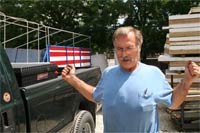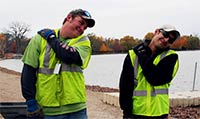A decrease in workers’ comp claims along with fewer back injuries, incidents of poison ivy, and vehicular accidents are just a few of the reasons Sarah Winkel, Museum Manager and Safety Coordinator, Bourbonnais Township Park District, is a firm believer that good things come out of Loss Control Reviews (LCR).
  The Bourbonnais team recently finished its LCR with PDRMA’s Risk Management Services Manager Dane Mall. The LCR is a process to evaluate, develop, maintain and enhance risk management best practices throughout the membership. In 2011, Risk Management Consultants continued working with members to incorporate Plans of Action (POA) into the LCR process, basing the plans on an analysis of each agency’s area(s) of highest losses and developing steps to decrease them. Those steps for Bourbonnais included better training, more resources for staff members, and new equipment. The Bourbonnais team recently finished its LCR with PDRMA’s Risk Management Services Manager Dane Mall. The LCR is a process to evaluate, develop, maintain and enhance risk management best practices throughout the membership. In 2011, Risk Management Consultants continued working with members to incorporate Plans of Action (POA) into the LCR process, basing the plans on an analysis of each agency’s area(s) of highest losses and developing steps to decrease them. Those steps for Bourbonnais included better training, more resources for staff members, and new equipment.
Mother Nature was one of the biggest culprits causing those losses. But how do you fight Mother Nature? It was actually pretty easy. Bourbonnais installed surge suppression systems to help prevent losses from lightning strikes, corrected some washout issues from creeks in their prairies, and reduced the number of poison ivy episodes with some help from PDRMA.
“Poison ivy is so difficult for us because it’s everywhere in our 172-acre park,” says Winkel. “But PDRMA has some wonderful resources — not only for poison ivy, but for everything. We used those resources to educate our staff about what to look for. And we keep those cards and pictures in the maintenance shop for easy access, along with wipes to use as a repellent.”
Injuries and accidents were two other big issues resulting in workers’ compensation claims. To help teach the staff better ways to complete tasks, the district implemented PDRMA’s 3 Points of Contact program to make sure everyone understood the importance of always having two hands and one foot or two feet and a hand on equipment when getting on and off.
“PDRMA has a great video,” Winkel explains. “We watch and discuss the video in our training sessions, put reminder stickers on all of our vehicles, and when supervisors see employees not using 3 Points of Contact, they remind them. Now we’re doing things safely. No more jumping out of vehicles or off of ladders — and no more twisted ankles.”
  Some injuries were coming more from lifting and bending, so Dr. Jim Clapper, Occupational and Injury Prevention Specialist, worked with the maintenance staff in the field, making suggestions on how to perform those tasks safely. Some injuries were coming more from lifting and bending, so Dr. Jim Clapper, Occupational and Injury Prevention Specialist, worked with the maintenance staff in the field, making suggestions on how to perform those tasks safely.
The POA called for improving fleet safety, too. Now, anyone driving for the district or driving park district vehicles must have training and complete a vehicle check before driving — and all vehicles undergo regular safety inspections.
It was a lot of change all at one time, and there was some staff resistance. “But as they see what we’re doing and why, and as they go through the PDRMA process, it’s making much more sense — and they realize it’s for their safety,” Winkel explains. “Now, people are paying more attention to how they do things instead of just reacting. Safety is more at the forefront of everyone’s minds.”
Safety records are better and injuries are down at the Forest Preserve of Will County, too, since the agency’s LCR review. “About two years ago we were incurring some back injuries — and some of them turned into workers’ comp claims,” explains John Fay, Superintendent of Operations. “So we took a look at it with PDRMA. They came in and did an audit, looking at how our employees were doing things — lifting, loading equipment, getting off tractors — and saw some things that needed to change.”
“We used the ergonomics audit report as a teaching tool to make our folks more aware of how they perform their tasks,” he explains. “PDRMA helped us take it a step further by bringing in people to teach staff the proper mechanics of lifting, bending and twisting. We have several different substations and Jesse Kinsland (PDRMA Risk Management Consultant) and Dr. Jim Clapper met with our crews to get them to routinely think about what they are doing and to question the body mechanics they use.”
One POA for the forest preserve included having coworkers watch each other’s body mechanics. Since no one wants to correct a coworker, staff members use a buzzer if they see someone completing a task incorrectly. And it’s working. “Now, if the guys hear a buzzer sound, they know they’re doing something wrong,” Fay comments. “And we’ve had a significant reduction in back injuries.
“We are moving forward with this plan, and appreciate the continued support from PDRMA to keep our people out of harm’s way,” Fay says. “Our POA is definitely helping to keep people aware and safe.”
|
|
|
|
If you have an LCR scheduled for 2013, here are some tips to help you prepare: Document, document, document — Keep written records of your inspections, training sessions, employee orientations and other safety-related activities.
Prepare your staff — Have your Safety Committee ensure all departments and facilities have the proper review form and understand the timelines and responsibilities of the LCR schedule.
Review specific documents early — Share your facility and program manuals, personnel policies and other large documents with your Risk Management Consultant early in the review process.
Use the PDRMA website — Log in to the new PDRMA website to find documents, resources and training materials to help improve your score.
Continue to improve — You often can increase the score your Risk Management Consultant initially assigns to LCR questions with a bit more effort.
Focus on your Loss Experience Plan of Action — If you do this early in the process, you can achieve the best possible score at the end of the review process. |

